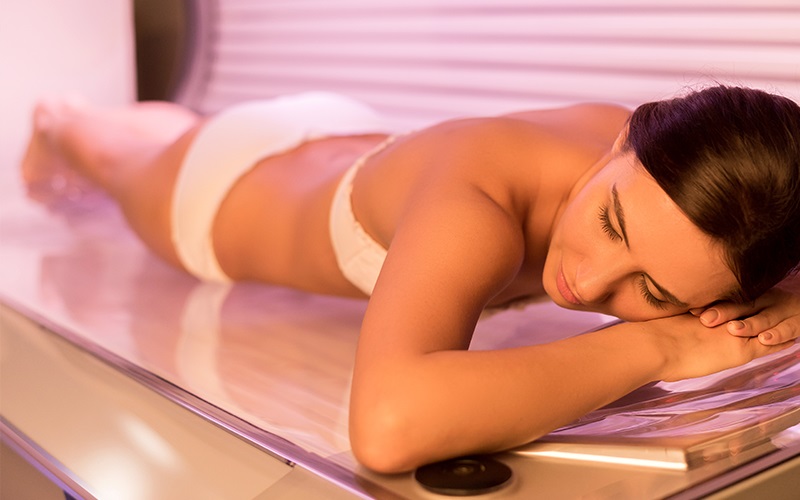It’s about to officially be summer, and for lots of us, that means fun in the sun. Whether you’re taking your children to Disney World, camping with your significant other or enjoying a trip to the beach with your friends, the American tradition of the summer vacation is alive and well.
For people with lighter skin, vacation planning begs the question: Should I get a base tan first? After all, no one wants to look like a vampire when they arrive on the beach or spend the trip recovering from an ugly sunburn they got on the first day. Doesn’t getting a base tan mean you’ll burn less easily and avoid increasing your risk of skin cancer?
Not so long ago, we thought the answer was yes. Back in the early ’90s, my mother visited the tanning salon every week before bathing suit season, and I regularly baked myself out by the pool.
Today, we know better. Tanning is skin damage, plain and simple, and getting a base tan for the summer will actually hurt you in the long run. No matter your natural skin tone, responsible sun protection habits will help prevent skin cancer and protect your skin’s youthful appearance.
Does a Base Tan Prevent Sunburn?
Technically, yes — by a very small amount. According to the Mayo Clinic, tanned skin is the equivalent of SPF 4 at most. That means your sun protection factor is increased by a factor of four or less.
While that may sound like a positive thing (you can stay out in the sun four times as long!), ask yourself: Would you spend all day in the sun wearing sunscreen of just SPF 4? Even my facial moisturizer is SPF 15. Dermatologists recommend wearing sunscreen of SPF 30 and reapplying it every two to three hours. According to Scientific American, the sun protection offered by a base tan is “completely meaningless.”
Even worse, having a base tan can provide vacationers with a false sense of safety. A 2013 study found that college students who got a base tan before spring break were actually more likely to get sunburned. This is probably because feeling “protected” by a base tan means you’re more likely to spend more time in the sun, and less likely to reapply sunscreen as often as you should.
Does a Base Tan Prevent Skin Damage?
No. In fact, a base tan (or any tan) actually IS skin damage.
Any change in skin color after sun exposure is a sign of damage from ultraviolet radiation. When the sun’s rays hit your skin, they damage the skin cells’ DNA, and melanin is created to prevent further damage. Dr. Anne Marie McNeill at the Skin Cancer Foundation explains, “Skin cells respond to damage from UV rays by producing more of the pigment melanin to protect themselves from further injury.”
Our modern standards of beauty tell us that tanned skin looks attractive, but you may regret your tanning habits later. Sun damage causes signs of premature aging later in life, including wrinkles, sagging skin, rough or leathery texture, dark spots, and discoloration. So while it may not be what we want to think about while pursuing a skin-kissed, bronzed summer glow, the truth is that sun exposure causes sun damage, and sun damages cause wrinkles and aging skin.
Does a Base Tan Prevent Skin Cancer?
No. Base tans provide no protection from skin cancer. In fact, the change in skin color indicates that UV rays have already damaged the DNA in your skin cells.
Because sun damage has a cumulative effect over a person’s lifetime, the more time we spend in the sun, the greater the chances that the UV radiation will cause skin cancer. The American Cancer Society classifies UV radiation as a carcinogen, explaining that “most skin cancers are a direct result of exposure to the UV rays in sunlight.”
As the Skin Cancer Foundation puts it, “a tan is the body’s response to damaged DNA in the skin cells — the skin darkens in order to prevent more damage, but the person’s risk of skin cancer is already increased.” Sunburns are even more problematic, as they are associated with a higher risk of melanoma, the most dangerous form of skin cancer.
How to Protect Your Skin
If a base tan isn’t the answer, what is? Sun-protective behavior is the single best way to protect your skin from irritating sunburn, unsightly skin damage and the trauma of skin cancer. Fortunately, these habits are inexpensive to implement and easy to learn.
- Wear sunscreen with an SPF of 15 to 30 every day.
- If you’re spending a lot of time outdoors, reapply every two to three hours.
- Seek shade, especially between 10 A.M. and 2 P.M.
- Wear protective clothing, like a sunhat and long sleeves.
- Never, ever go to a tanning bed.
Finally, consider embracing the beauty of your natural skin tone. As our world becomes more diverse, our standards of beauty are expanding. Healthy skin and body-positive confidence never go out of style.
Of course, plenty of us still want a sun-kissed glow during our summer travels — myself included! I’ll be using one of our dermatologists’ favorite sunless tanners and plenty of sunscreen so that I can feel beautiful while protecting my skin for life.
Looking to Visit a Dermatologist?
We have multiple locations throughout the country, so fill out our simple online form to get in touch with us. One of our local team members will reach out to you shortly to answer your questions or schedule an appointment for you to visit us soon.
Find a location near me
or

